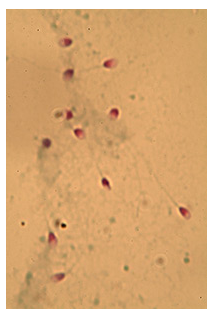Archival Notice
This is an archive page that is no longer being updated. It may contain outdated information and links may no longer function as originally intended.
Home | Glossary | Resources | Help | Contact Us | Course Map
Human semen contains unusually high concentrations of acid phosphatase, which can therefore be the basis of a screening test. The reaction is based on the hydrolysis of phosphate esters and detection of the liberated organic moiety by production of a color complex. For example, the reaction of acid phosphatase with sodium alphanapthylphosphate and fast blue B to produce a purple-blue coloration. As with the screening test for blood, a positive result is the rapid formation of the intensely colored product – less than 20 seconds or so, or 30 seconds at most.
The best identification of semen is from its microscopy. The morphology and dimensions of the human spermatozoon are unique. The small sperm, particularly if they have lost their tails, can be difficult to locate microscopically especially in samples which have bacterial or yeast infection. Detection is simplified by histopathological staining. The most usual stain is popularly known as Christmas tree stain because of the bright colors. It utilizes nuclear fast red that differentially stains the DNA-containing head bright crimson, and a counter-stain of picric acid - indigocarmine (PIC) that stains the tails green-blue-gray. The traditional histological staining of hematoxylin and eosin (H&E) is also used, as is Giemsa stain.
Problems may be encountered if the seminal fluid is from a man who has a low sperm count (oligospermia) or who has no spermatozoa present in his seminal fluid (aspermia). In situations where the presumptive alkaline phosphate test indicates the presence of semen, but the microscopical analysis yields no detectable spermatozoa, tests are carried out to determine the presence of a protein, P30, or prostate specific antigen (PSA), which is only found in high concentration in human semen. Some laboratories even use P30 testing in place of microscopical examination for semen identification. It can be detected by precipitin reaction with a specific antiserum using the Ouchterlony process. There is also a quantitative immunological test utilizing an enzyme-linked reaction (ELISA).
However, the currently accepted method of choice for identification of semen in all circumstances is detection of p30 using the ABAcard® test strips manufactured by Abacus Diagnostics, Inc. The strips work in the same way as described above for confirmation of blood, except that they use anti-p30 monoclonal and polyclonal antisera, and a pink dye.
Additional Online Courses
- What Every First Responding Officer Should Know About DNA Evidence
- Collecting DNA Evidence at Property Crime Scenes
- DNA – A Prosecutor’s Practice Notebook
- Crime Scene and DNA Basics
- Laboratory Safety Programs
- DNA Amplification
- Population Genetics and Statistics
- Non-STR DNA Markers: SNPs, Y-STRs, LCN and mtDNA
- Firearms Examiner Training
- Forensic DNA Education for Law Enforcement Decisionmakers
- What Every Investigator and Evidence Technician Should Know About DNA Evidence
- Principles of Forensic DNA for Officers of the Court
- Law 101: Legal Guide for the Forensic Expert
- Laboratory Orientation and Testing of Body Fluids and Tissues
- DNA Extraction and Quantitation
- STR Data Analysis and Interpretation
- Communication Skills, Report Writing, and Courtroom Testimony
- Español for Law Enforcement
- Amplified DNA Product Separation for Forensic Analysts


